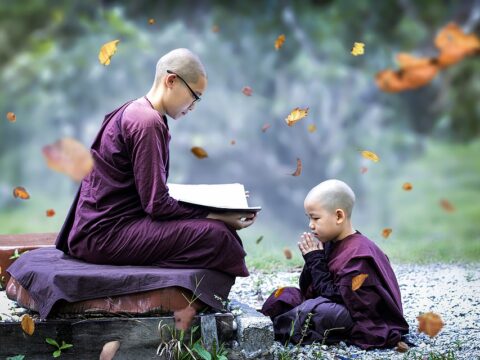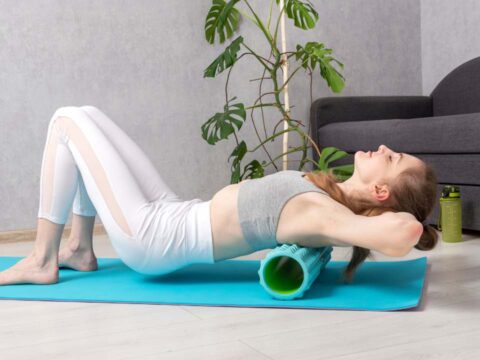If you’re feeling too tired to do something, you’re not alone. Many people feel that way. Some people are just too overworked or stressed to get adequate rest, while others may feel drained by a physical ailment, a psychological condition, or the side effects of medication. No matter what the cause, everyone can benefit from the respite that a restorative yoga practice provides.
Why should one not have a vigorous practice when they are deeply fatigued? This is because despite a dynamic practice’s initial invigorating jolt, it can be depleting.
Restorative yoga soothes the senses, so they stop urging the mind and nervous system to react and instead turn their attention inward—on the breath or embedded tension, for example. These asanas also lower anxiety levels and calm the fight-or-flight response. The stress-induced outpouring of adrenalin and other hormones that taxes the systems of the body.
Video – Yoga for Stress Relief
Restorative yoga calms the senses, so that instead of urging the mind and nervous system to react, they turn their attention inward – on the breath or tension that is held within, for example.
In addition, if you are constantly tired, it can be very difficult to do something as simple as standing up straight. When your shoulders droop and your spine bends, it puts pressure on your chest and stomach, making it hard to breathe.
Podcast
Under these circumstances, it can be hard to find the energy to do a yoga pose correctly. This is why it is helpful to use props such as blankets, pillows, and belts in restorative yoga. With these props, you can do a backbend without putting much effort into it. This will help you feel the benefits of the pose without using up all your energy.
The first posture of this sequence, upward plank pose, broadens and lifts the chest and frontal diaphragm away from the lower body. This posture encourages the inhalation to expand outward and upward toward the top chest, bringing lightness, while the abdomen can flow downward and soften on the exhalation.
Additionally, supported forward bends help to calm the mind and body by drawing the focus of the brain and senses inward. Furthermore, the supports and blankets help to hold the organs in the front of the body, while the back and kidneys are able to relax and expand, lessening stress even more.
Blankets, bolsters, blocks, and belts are all essential props to use in a restorative yoga practice. With their help, passive supported backbends allow the chest to expand without requiring any physical effort. This then allows the body and mind to open up to the stimulating effects of the pose without depleting any energy reserves that might already be low.

Inversions give the heart a break from pumping blood to the brain and let gravity help refresh the legs and lower body. This helps the body’s systems, especially the immune and endocrine systems, and addresses various kinds of hormonal issues—like adrenal fatigue.
If you experience pain or strain while doing any of these asanas, you may need to rearrange your props or gradually build up your endurance for each pose.
6 Yoga Poses for Stress Relief, Depression, Digestion & More
1. Shoulderstand (Salamba Sarvangasana)
Start by lying on your back on a mat. You may want to add two folded blankets under each shoulder for support. Bring your knees to your chest, and then lift your hips and tailbone off the mat, so your body forms a bridge.
Hold this pose, and then lift one leg at a time into the air, keeping your hips and back stable. If this is too difficult, you can start by doing the pose with your legs against a wall.If you need more support, move your hands either up or down your back, depending on where they originally were and what feels best.
Be careful not to move your head back and forth as you do this. Just keep your neck straight and your eyes focused upward to avoid neck injuries with this pose. HOLD: Hold this pose for 10 deep inhalations and exhalations. Then roll out of it by either slowly releasing your legs downward or bringing them over your head and then rolling your spine to the floor.
Benefits
- Calms the brain and helps relieve stress and mild depression
- Improves digestion
- Helps relieve the symptoms of menopause
- Stretches the shoulders and neck
- Tones the legs and buttocks
- Reduces fatigue and alleviates insomnia
2. Marichi’s Pose (Marichyasana A)
Sit down on your mat with your legs stretching out in front of you. Bend your left knee and bring your foot to rest flat on the mat. Place your left shin behind or in your left armpit. Hold onto a belt, a necktie, a rolled-up beach towel, or yoga strap with your right hand.
Reach your left arm around the outside of your left leg and try to grab the belt, tie, towel, or strap with your left hand. If you can’t reach it, just stretch as far as you can. Hold this position for 30 seconds to 1 minute, breathing deeply the whole time. As you sit back up, take a deep breath in. Repeat these steps with your other leg bent up.
Benefits
- Calms the brain
- A therapeutic application for flatulence, constipation, and obesity
- Stretches the spine and shoulders
- Improves digestion
3. Head-to-Knee Forward Bend (Janu Sirsasana)
The Head-to-Knee Forward Stretch is an excellent way to release lower back tension and stretch the hamstrings and inner thighs. The head-to-knee Forward Bend is also known as Janu Sirsasana. It is typically practiced at the end of a yoga sequence. It is not about putting your head directly on the knee, but rather, focusing on lengthening your spine and stretching your hamstrings.
Learning how to do Head-to-Kneele Forward Bend properly requires several steps. The best way to avoid injury is to avoid aggressively pushing yourself into the pose. Come into the pose to a comfortable level, and over time, your muscles will naturally release into the forward bend.
To prevent locking your knee, you can raise your pelvis with a folded blanket or bolster. If you have back problems, it is best to skip this pose.
Beginner yoga practitioners can use a variation of this pose or modify it. The pose is a little difficult to perform if your knees are stiff. A blanket placed underneath your knee helps stretch stiff knees. Try practicing this stretch while wearing a yoga hat to protect your shoulders. Once you’ve practiced the pose a few times, you’ll be amazed at how easy it is.
The Head-to-Knee Forward Fold can be performed with a yoga block or chair. It is very beneficial for stretches and strengthening your back muscles and reducing the effects of sitting for long periods of time.
As an added benefit, this pose helps you combat low back pain and soothes the mind. It has been known to relieve menopause symptoms, so it’s recommended for women who are experiencing discomfort from hormone imbalances.
Benefits
- Calms the brain and helps relieve mild depression
- Stretches the spine, shoulders, hamstrings, and groins
- Improves digestion
- Helps relieve the symptoms of menopause
- Relieves anxiety, fatigue, and headaches
4. Reclining Bound Angle Pose (Supta Baddha Konasana)
Sit on your yoga mat with your legs outstretched in front of you. Bend your knees up and bring the bottoms of your feet together in a diamond shape. Slowly drop your knees opposite from each other as you lean backward.
Place your elbows on your mat and lean back, using your additional blankets or blocks to support your knees. Create a natural curve in your lower back by adjusting your weight on your buttocks.
Starting at your toes, let all of the tension in your body go. Work your way up, releasing your knees, then your arms (palms up), shoulders, neck, head, and spine. As you close your eyes, let go of everything that’s causing you stress and tension and fully relax your body.
Sit with your knees bent and your feet flat on the ground. Lean back, keeping your back straight, and place your hands on the ground behind you. Hold this pose for up to 10 minutes, breathing deeply. When you’re done, bring your knees together and roll onto your side. Use your arms to push off the ground and sit up.
Benefits
- Decreases tension in your muscles and body
- Stretches the inner thighs, groins, and knees
- Helps relieve the symptoms of stress, mild depression, and menopause
- Relieves fatigue by increasing energy levels
Cautions
Don’t do this pose if you have a groin or knee injury, unless you’re working with a professional instructor who can give you guidance, or you’re using supports like blankets or blocks under your outer thighs.
If you are aged 35-50, you can have a positive impact on your future health by making healthy choices and following preventive healthcare today. Improve your future wellbeing by taking care of yourself during early perimenopause, perimenopause, and early menopause.
5. Shalamba Purvottanasana (Over two chairs or a bed)
Slowly lower your back to the bolster, keeping your spine straight. Place a long, narrow pillow across the seats of two chairs positioned side by side, a few feet from the wall, with most of the pillow on the chair farthest away from the wall.
Fold a blanket and place it at the back end of the pillow. Sit on the edge of the chair with the pillow a few inches away from your buttocks. Slowly lower your back to the pillow, keeping your spine straight.
Lie with your knees bent, feet on the floor and your back over a bolster. Place a blanket under the back of your neck and head so that your head isn’t tilting backward. Extend your legs and place your toes on the wall, with your heels on the floor. Slowly push away from the wall to straighten your legs.
Rotate your shoulders so that your chest is lifted and expanded. Let your arms dangle to your sides. After a couple minutes, you might want to change the position of your arms. You can either rest your hands on your front ribs or grab your elbows and stretch your arms overhead.
Stay here for up to 10 minutes while continuing to breathe deeply. To come out of this position, bend your knees and use your hands to help you sit up slowly.
Benefits
- Relieves headache, insomnia, back pain, and fatigue
- Calms the brain and helps relieve stress and mild depression
- Energizes the body
- Helps relieve the symptoms of menopause
- Helps prevent osteoporosis
- Stretches the shoulders, hamstrings, calves, arches, and hands
- Strengthens the arms and legs
- Improves digestion
- Therapeutic for flat feet and sciatica
6. Supta Baddha Konasana (Over Bolsters)
Sit on the ground with your knees bent and a bolster placed vertically a few inches behind you. Fold a blanket and place it on the other end of the bolster for your head. Join the soles of your feet together and tie a large loop through a belt. Slip the belt over your head and around your lower back.
Pull the loop in front of you over your toes and underneath your feet so that the sides of your belt are on the inside edges of your legs. Bring your feet closer to your pelvis and tighten the belt so that it is holding your legs close to your torso.
Place a small blanket or towel under your head if it tilts back too much, and slide your sacrum and buttocks toward your feet so that your lower back feels long. If you feel any compression in the lower back, you may need to slide a bit more off the bolster toward your feet.
Roll your shoulders back so that your shoulder blades are away from your neck. Spread your chest from the center to the sides and let your arms release to the floor, spreading away from your chest. Your palms should be facing up and your shoulders should be rotated outward.
Benefits
- Calms the brain
- Strengthens and stretches the inner and back legs and the spine
- Tones the abdominal muscles
Come to lie on your back on the floor and place a support under each of your knees. Close your eyes and relax for 10 minutes. As you breathe in, let your chest expand and your stomach recede.




